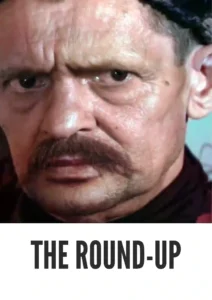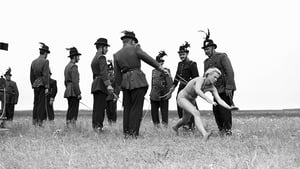Contact: [email protected]
Video Sources 0 Views

Synopsis
The Round-Up 1966: A Harrowing Tale of Power, Oppression, and Resistance

Introduction
In the annals of cinematic history, “The Round-Up 1966” stands as a powerful and poignant exploration of power, oppression, and resistance. Directed by the acclaimed Hungarian filmmaker Miklós Jancsó, this gripping drama transports viewers to the heart of 19th-century Hungary, where a group of political prisoners face interrogation, torture, and betrayal at the hands of their captors. As we delve into the harrowing world of “The Round-Up,” we uncover the significance of its early colored films version and its enduring legacy as a searing indictment of tyranny and injustice.
Check The Full Colorized Movies List
Check Our Colorized Movies Trailer Channel
The Artistry of “The Round-Up”
Jancsó’s Visionary Direction
At the helm of “The Round-Up” is the visionary Hungarian director Miklós Jancsó, whose bold and uncompromising approach to filmmaking has earned him international acclaim. With its stunning cinematography, fluid camerawork, and sparse dialogue, the film is a masterclass in visual storytelling that transports viewers to the heart of the action with breathtaking immediacy and intensity. Jancsó’s keen eye for composition and his innovative use of space and movement create a sense of tension and unease that permeates every frame, drawing audiences into a world of political intrigue and moral ambiguity.
Compelling Performances
Central to the film’s impact are the compelling performances of its ensemble cast, led by János Görbe and Zoltán Latinovits in the roles of Colonel Geréb and Lieutenant Gedeon, respectively. Görbe’s portrayal of the ruthless Colonel Geréb is a tour de force of villainy and cruelty, capturing the depravity and amorality of a man drunk on power. Opposite him, Latinovits shines as the principled Lieutenant Gedeon, whose unwavering commitment to his beliefs serves as a beacon of hope in a world consumed by darkness and despair. Together, they form a dynamic duo whose struggle for survival lies at the heart of the film’s narrative.
Revisiting the Storytelling Mastery: Plot and Themes
A Gripping Tale of Power and Oppression
“The Round-Up” unfolds as a gripping tale of power and oppression, set against the backdrop of 19th-century Hungary during the aftermath of the failed revolution of 1848. As Colonel Geréb and his ruthless henchmen interrogate and torture a group of political prisoners suspected of treason, they plunge deeper into a moral abyss from which there is no escape. Through its relentless depiction of brutality and betrayal, the film exposes the corrupting influence of power and the devastating consequences of unchecked authority.
Themes of Resistance and Resilience
At the heart of “The Round-Up” are its themes of resistance and resilience, which resonate throughout the film with profound emotional resonance. As the prisoners face interrogation, torture, and death at the hands of their captors, they refuse to surrender their dignity or their principles, defiantly clinging to their beliefs in the face of overwhelming adversity. Through their acts of resistance and solidarity, Jancsó invites viewers to contemplate the power of the human spirit to endure and prevail in the darkest of times.
The Dynamic Relationship Between Captor and Captive
The Tyranny of Power
“The Round-Up” serves as a chilling reminder of the tyranny of power and its ability to corrupt and destroy those who wield it without mercy or restraint. As Colonel Geréb and his men subject the prisoners to increasingly brutal methods of interrogation and punishment, they reveal the depths of their depravity and moral bankruptcy, sacrificing their humanity on the altar of authority and control.
The Triumph of the Human Spirit
Against the backdrop of oppression and cruelty, “The Round-Up” celebrates the triumph of the human spirit in the face of adversity. Despite the horrors they endure, the prisoners refuse to be broken or silenced, defiantly asserting their dignity and their humanity in the face of overwhelming odds. Through their acts of resistance and solidarity, Jancsó highlights the resilience and strength of the human spirit, offering a powerful testament to the enduring power of hope and courage in the darkest of times.
A Visual and Technical Achievement
Cinematic Grandeur
Shot in luminous black-and-white, “The Round-Up” is a visual tour de force that captures the beauty and brutality of 19th-century Hungary with breathtaking clarity and precision. From its sweeping vistas to its intimate interiors, every frame is a work of art, meticulously composed and imbued with symbolic meaning. Jancsó’s use of space, movement, and symbolism creates a mesmerizing and immersive experience that transports viewers to the heart of the action, inviting them to bear witness to the triumphs and tragedies of a bygone era.
Early Colored Films Version
In a departure from convention, the filmmakers behind “The Round-Up” experimented with an early colored films version of the movie, offering audiences a new perspective on its timeless tale. This innovative approach to colorization adds depth and nuance to the film’s visuals, enriching its already mesmerizing aesthetic and enhancing the overall viewing experience.
Behind the Scenes of “The Round-Up”
Jancsó’s Artistic Process
Behind the camera, Miklós Jancsó and his team worked tirelessly to bring “The Round-Up” to life with authenticity and integrity. From the elaborate set designs to the evocative cinematography and haunting score, every aspect of the production was crafted with meticulous care and attention to detail. Jancsó’s uncompromising commitment to his artistic vision shines through in every frame, as he pushes the boundaries of cinematic expression to create a work of unparalleled beauty and emotional resonance.
Collaborative Creativity
One of the most remarkable aspects of “The Round-Up” is the collaborative spirit that infused every aspect of its creation. From the dedicated performances of the cast to the innovative contributions of the production crew, each member of the team played a vital role in bringing Jancsó’s vision to life. Through their collective efforts, they created a cinematic masterpiece that continues to inspire and captivate audiences around the world.
Legacy and Influence on Cinema
Critical Acclaim and Cultural Impact
Upon its release, “The Round-Up” received widespread critical acclaim, with particular praise for its stunning visuals, powerful performances, and profound thematic depth. Over the years, the film has attained legendary status among cinephiles and scholars alike, inspiring countless filmmakers to explore the complexities of power, oppression, and resistance with honesty and authenticity.
Inspiring Future Generations
“The Round-Up” has left an indelible mark on the world of cinema, inspiring filmmakers and audiences alike to contemplate the timeless themes of justice, freedom, and human dignity. Its enduring legacy serves as a testament to the enduring power of cinema to bear witness to the struggles and triumphs of the human spirit in the face of adversity.
Where to Watch “The Round-Up 1966 Full Movie”?
For those eager to experience the epic grandeur of “The Round-Up” in its entirety, the film is readily available on various streaming platforms and home video releases. Whether you’re a seasoned cinephile or a newcomer to the world of Hungarian cinema, “The Round-Up” promises a journey unlike any other—a journey into the heart of power, oppression, and resistance.
In Conclusion
“The Round-Up 1966” stands as a timeless testament to the power of cinema to bear witness to the struggles and triumphs of the human spirit. With its stunning visuals, powerful performances, and profound thematic depth, the film continues to resonate with audiences around the world, inviting them to contemplate the nature of power, oppression, and resistance with courage, compassion, and understanding. As we revisit this cinematic masterpiece, let us embrace its invitation to bear witness to the enduring quest for justice, freedom, and human dignity in the face of tyranny and oppression.












